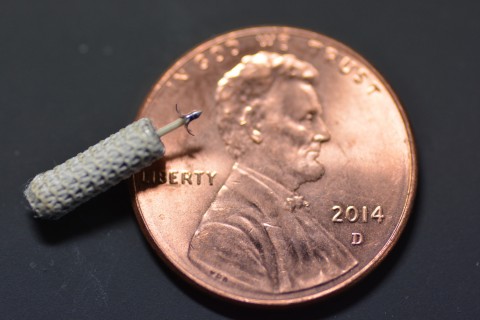EBR Systems, Inc., developer of the world’s only wireless cardiac pacing system for heart failure, today announced that the U.S. Food and Drug Administration (FDA) has granted Breakthrough Device Designation for the WiSE CRT System for the treatment of heart failure.
This press release features multimedia. View the full release here: https://www.businesswire.com/news/home/20190910005220/en/

The WiSE CRT System Electrode (Photo: Business Wire)
The FDA created this designation and its associated program in 2017 for certain devices providing more effective treatment of life-threatening or irreversibly debilitating diseases or conditions. Under the program, the FDA will provide EBR with priority review and interactive communication.
The WiSE (Wireless Stimulation Endocardially) CRT System is designed to improve the heart’s pumping ability by synchronizing the left and right ventricles to distribute blood to the lungs and body more effectively. To regulate precise pacing from within the heart, WiSE uses a unique, wireless electrode the size of a grain of rice. It is implanted in the left ventricle wall during a minimally invasive procedure. This approach provides the cardiologist greater choice of pacing locations, enabling patient-specific customization of pacing site and may improve CRT response.
The WiSE CRT System is being evaluated in the IDE-approved SOLVE CRT clinical trial. This prospective randomized, double blinded pivotal trial is intended to assess safety and efficacy of WiSE pacing technology in support of U.S. FDA approval. The study is enrolling 350 heart failure patients in the United States, Europe, and Australia who have failed to respond to — or are otherwise unable to receive — conventional cardiac resynchronization therapy (CRT).
“This Breakthrough Device Designation underscores the need for novel solutions for heart failure patients, who have few options today,” said John McCutcheon, President and CEO of EBR Systems. “We are excited that the WiSE System has received Breakthrough Status, which will enhance the review process to bring this important technology to these patients.”
Clinical studies featuring the WiSE CRT System and the SOLVE CRT study will be presented at the Heart Failure Society of America meeting between September 13 and 16 in Philadelphia, PA.
About Heart Failure and Cardiac Resynchronization Therapy (CRT)
Heart failure is a serious condition in which the heart is unable to pump enough blood to meet the body’s demands. A progressive, debilitating disease, heart failure often occurs when electrical signals within the heart are disrupted, causing the heart’s ventricles to beat in an uncoordinated or unsynchronized pattern. That enlarges the left ventricle and makes the heart less efficient.
Cardiac resynchronization therapy is a proven treatment that improves symptoms and reduces hospitalizations and mortality1,2 by electrically stimulating the heart. Also referred to as biventricular pacing, CRT uses wire leads to synchronize the left and the right ventricles so that the two chambers beat together, thereby improving the heart’s efficiency. Approximately 200,000 patients are treated worldwide each year with traditional CRT. 3
EBR Systems’ WiSE Technology
Approximately 30 percent of patients receiving conventional CRT do not respond to the therapy. A major cause of this shortcoming is believed to be the inconsistency of results achieved using wire leads to pace the left ventricle from within the coronary sinus vein on the epicardial (exterior) surface of the heart. Although it is generally accepted that stimulation of the left ventricle is preferable from inside the heart (endocardially), wire leads placed inside the left ventricle can cause clots, heart attacks or strokes. Additionally, wire leads can break, dislodge or otherwise fail, leading to complications in roughly 12 percent of cases.4 The financial impact of these issues is profound. More than $1 billion of $3.5 billion spent annually on CRT devices provides no patient benefit.5
EBR Systems’ WiSE CRT System is the world’s only wireless, endocardial (inside the heart) pacing system in clinical use for stimulating the heart’s left ventricle. This has long been a goal of cardiac pacing companies since internal stimulation of the left ventricle is thought to be a potentially superior, more anatomically correct pacing location. WiSE Technology enables cardiac pacing of the left ventricle with a novel cardiac implant that is roughly the size of a large grain of rice. The need for a pacing wire on the outside of the heart’s left ventricle – and the attendant problems – are potentially eliminated.
The WiSE™ CRT System is CE Mark approved. In the U.S., it is an investigational device and not available for sale.
About EBR Systems
Silicon Valley-based EBR Systems is dedicated to superior treatment of cardiac rhythm disease by providing more physiologically effective stimulation through wireless cardiac pacing. The company’s patented proprietary Wireless Stimulation Endocardially (WiSE) technology was developed to eliminate the need for cardiac pacing leads, historically the major source of complications and reliability issues in cardiac rhythm disease management. The company’s initial product is designed to eliminate the need for coronary sinus leads to stimulate the left ventricle in heart failure patients requiring CRT. Future products will address wireless endocardial stimulation for bradycardia and other non-cardiac indications. EBR Systems is backed by respected private equity investors including Brandon Capital Partners, M.H. Carnegie & Co., Split Rock Partners, Ascension Ventures and Emergent Medical Partners.
1 McAlister FA, Ezekowitz J, Hooton, N, et al. Cardiac Resynchronization Therapy for Patients with Left Ventricular Systolic Dysfunction: A Systematic Review. JAMA. 2007; 297(22): 2502-14.
2 Abraham WT, Fisher WG, Smith AL, et al. Cardiac Resynchronization in Chronic Heart Failure. N Engl J Med. 2002; 346: 1845-53.
3 JP Morgan, Cardiac Rhythm Management (CRM) Market Model, August, 2017, Michael Weinstein
4 Leon AR, Abraham WT, Curtis AB et.al. Safety of Transvenous Cardiac Resynchronization System Implantation in Patients with Chronic Heart Failure. J Am Coll Cardiol. 2005; 46: 2348-56.
5 Poole JE, Gleva MJ, Mela T, et.al. Complication Rates Associate with Pacemaker or ICD Generator Replacements and Upgrade Procedures. Circulation. 2010;122:1553-1561.
View source version on businesswire.com: https://www.businesswire.com/news/home/20190910005220/en/
